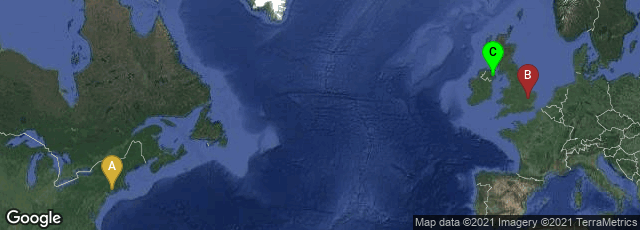
A: New Haven, Connecticut, United States, B: Cambridge, England, United Kingdom, C: Belfast, Northern Ireland, United Kingdom
In a letter to Irish physicist Thomas Andrews of Belfast dated July 15, 1875 Scottish physicist James Clerk Maxwell, then at the Cavendish Laboratory at Cambridge, wrote "I think you know Prof. J. Willard Gibbs's (Yale College Connecticut) graphical methods in thermodynamics. Last winter I made several attempts to model the surface which he suggests, in which the three coordinates are volume, entropy and energy. The numerical data about entropy can only be obtained by integration from data which are for most bodies very insufficient, and besides it would require a very unwieldy model to get all the features, say of CO2, well represented, so I made no attempt at accuracy, but modelled a fictitious substance, in which the volume is greater when solid than when liquid; and in which, as in water, the saturated vapour becomes superheated by compression. When I had at last got a plaster cast I drew on it lines of equal pressure and temperature, so as to get a rough motion of their forms. This I did by placing the model in sunlight, and tracing the curve when the rays just grazed the surface... I send you a sketch of these lines...."
The result of Maxwell's clay modelling project, an early information visualization project known as Maxwell's thermodynamic surface, is an 1874 sculpture which provides a
"three-dimensional plot of the various states of a fictitious substance with water-like properties. This plot has coordinates volume (x), entropy (y), and energy (z). It was based on the American scientist Josiah Willard Gibbs’ graphical thermodynamics papers of 1873. The model, in Maxwell's words, allowed 'the principal features of known substances [to] be represented on a convenient scale.'
"Gibbs' papers defined what Gibbs called the 'thermodynamic surface,' which expressed the relationship between the volume, entropy, and energy of a substance at different temperatures and pressures. However, Gibbs did not include any diagrams of this surface. After receiving reprints of Gibbs' papers, Maxwell recognized the insight afforded by Gibbs' new point of view and set about to construct physical three-dimensional models of the surface. This reflected Maxwell's talent as a strong visual thinker and prefigured modern scientific visualization techniques.
"Maxwell sculpted the original model in clay and made three plaster casts of the clay model, sending one to Gibbs as a gift, keeping the other two in his laboratory at Cambridge University. Maxwell's copy is on display at the Cavendish Laboratory of Cambridge University, while Gibbs' copy is on display at the Sloane Physics Laboratory of Yale University, where Gibbs held a professorship" (Wikipedia article on Maxwell's thermodynamic surface, accessed 12-25-2012).